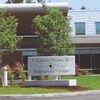Processing Your Payment
Please do not leave this page until complete. This can take a few moments.
Patricia Quinn leads Amtrak's Downeaster to a record-setting year
Patricia Quinn, executive director of the Northern New England Passenger Rail Authority, half-jokingly refers to the Amtrak Downeaster passenger service she oversees as her “third child.”
As she gets ready to head into work, Quinn says she instinctively looks at the clock and pictures where her trains should be at that very moment. If she's within earshot of a crossing where a train should be rolling through, she begins to worry if that moment passes without hearing the reassuring whistle of the locomotive. When a major snowstorm hits, the risk of passengers being stranded at either end of the Boston-to-Brunswick line keeps her anxious until the last train arrives safely.
“This is a 24/7 job,” she says. “It never stops. That's a challenge, because it means I'm never fully 'off.'”
Since assuming NNEPRA's reins in September 2005 — five years after being hired as a part-time marketing consultant and almost four years after the Downeaster passenger service began between Portland and Boston — Quinn has seen yearly ridership increase 123% to a record-setting 556,347 passengers in fiscal year 2013. That's a 5% increase over 2012. The Downeaster also posted record revenues of $8.1 million last year, a 9% increase over 2012, despite 133 train cancellations due to repairs of a bridge in Massachusetts, the Boston Marathon bombing and bad weather.
She's particularly pleased that the twice-daily Downeaster service to Freeport and Brunswick exceeded daily average ridership projections in 2013 by 50% in its first year of operation, and that the Downeaster's customer service satisfaction rating of 93% is the highest of any Amtrak route in the country.
Those numbers don't happen by accident. Quinn says she regularly reviews with her staff and NNEPRA's board the latest metrics about ridership, safety, costs and public satisfaction ratings — with a diligence akin to the continuous improvement processes in manufacturing popularized by W. Edwards Deming.
“If even one piece isn't strong, the whole service will suffer,” she says. “The challenge of this position is keeping all those balls up in the air and not losing track of a single one.”
In 2013, NNEPRA exceeded its benchmark goal of recovering at least 50% of costs through operating revenues, with $9.1 million or 55% recovered. An additional $6.1 million (36%) in federal funding and $1.5 million in state funds helped pay for the Downeaster service.
Recently, she negotiated an end to a $200,000-plus yearly lease payment to the Massachusetts Bay Transportation Authority for access to its tracks, platforms and stations and use of its ticket agents at North Station by pointing out how her agency had secured a federal grant that paid 80% of the $26 million cost of improving the 38-mile long stretch of commuter rail tracks the MBTA shares with the Downeaster.
“We were able to demonstrate that over the course of time, our partnership has been beneficial to them, both in helping Massachusetts get more federal funding and in increasing ridership,” she says. “As a quasi-governmental agency, it's important not only for us to succeed, but also all of our stakeholder partners. Our mission is to help them succeed as well.”
Ridership and fuel costs are two wild card factors. Since fuel costs are largely out of her control, Quinn says her team is “extremely focused” on building revenues through increased ridership. Promotions are key, such as the innovative approach NNEPRA took to the Massachusetts bridge repair project that blocked through-trips for 36 weekend trains to or from Boston last winter and spring.
On a typical Saturday, she says, the Downeaster's trains would carry 1,500 riders. The first Saturday the bridge was out, ridership plummeted to 280.
“I sat down with my marketing director and said, 'What can we do?'” she recalls.
The answer was a “Try the Train” deal offering $5 fares between Haverhill, Mass., and Maine. Tip sheets were created identifying places at each stop that train riders could check out for the day. The special fares were promoted through social media blasts teasing, “Hey, we go to Brunswick, Maine!”
“Guess what? Our northbound trains were sold out,” Quinn says.
Controlling food costs is also important. Quinn has set the goal of recovering 100% of the Downeaster's food service costs, which even now, at the 80% mark, exceed Amtrak's nationwide average. To accomplish that, Quinn maintains a detailed calendar matching each day's food menus with particular events that are likely to drive that day's ridership. If the Celtics are playing in Boston, she makes sure the train is stocked with Shipyard beers and ales. A Bruins' crowd gets Bud Light to wash down the pulled-pork sandwiches she knows they'll like. Afternoon riders are likely to want parfaits and salads. And if there's a school group scheduled, she makes sure the train has bulked up on candy bars and potato chips.
Another example of her team's creativity in fostering high customer-satisfaction levels is the “inconvenience voucher” that's intended to turn a rider disgruntled by some failure of service into a customer who's willing to give the Downeaster a second chance. Quinn says she's empowered Downeaster's conductors to give out a voucher for a free trip whenever they feel it's warranted.
Quinn says the program reflects the importance of customer satisfaction, and it took some persuasion and a “long time for Amtrak to buy into it.”
Asked if she's earned a reputation for being a rebel within the national Amtrak system, Quinn smiles and says, “Pretty much.”
“We push them to think outside of the box,” she says of her relationship with Amtrak. “It's a continual effort, and it's not always easy. But it all goes back to the relationship we're trying to establish with our customers. Our view is that if something we try goes well and our customers like it, it reflects favorably back on the Amtrak service.”
The expansion of the Downeaster line to Freeport and Brunswick, she says, is a major milestone that was accomplished with a lot of help from stakeholders. The limited twice-daily service, which opened in November 2012, exceeded daily average ridership projections by 50% in 2013 and contributed to 2013's record-setting ridership tally.
Although Quinn says it's hard to quantify the financial impact the extension has had on Freeport and Brunswick businesses, she notes that the Downeaster carried more than 100,000 tourists into Maine last year and that the number of tourists taking day trips into Maine increased more than 30%. Brunswick Downtown Association named NNEPRA its 2013 Member of the Year, citing its impact on bringing new visitors to the college town.
Even so, Quinn says the full benefits of the Downeaster's northward extension won't be felt until a $12 million layover facility is built in Brunswick to provide overnight shelter for up to three diesel-powered locomotives and their passenger train cars. That would end the runs of empty trains to the Portland layover site, eliminate idling trains between runs and enable NNEPRA to add one to three additional trips to and from the Brunswick terminus.
Quinn acknowledges the Brunswick project has tested her leadership skills, largely because of the strong opposition it faced from a local Brunswick neighborhood group. She's met with opponents numerous times, created an advisory group to assist NNEPRA in designing the building and is now awaiting final authorization of the project by the Federal Railroad Administration.
“I'm hoping to hear this spring,” she says. “I'll be ready to go.”
Quinn admits she relishes the challenges that regularly come her way, as well as working toward the long-term goals of having five daily round trips between Brunswick and Boston, adding one or two daily round trips between Portland and Boston, reducing the Portland-Boston travel time by 15 minutes to two hours and 15 minutes and eventually adding a new line of service between Lewiston-Auburn and Portland.
“I've pretty much always been a can-do person,” she says. “I enjoy a good challenge. I'm not a very good 'status quo' person.”
DOWNLOAD PDFs
Patricia Quinn, Business Leader of the Year 2014
Read more
Peter Rinck puts a technological spin on 'Mad Men'
Cross Insurance CEO Royce Cross builds on his father's legacy
Introducing our 2014 Business Leaders of the Year
Peter Rinck puts a technological spin on 'Mad Men'
Cross Insurance CEO Royce Cross builds on his father's legacy
Introducing our 2014 Business Leaders of the Year
DEP chief scrutinizes Downeaster train depot
Downeaster to add Kennebunk stop
Downeaster revenue expected to dip by $1M












Comments